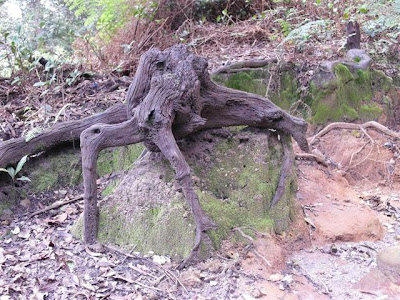 |
DOMAS IS GOLD
There's a French proverb which says, 'Don't dance on a volcano'. It means beware of someone who has nothing to lose. I was not only dancing on Kawah Domas but frolicking my first experience stepping on a crater of gold, where Kawah Domas had derived its name. Kawah Domas had not threatened me in anyway and I was free to reward myself with Domas' gifts from nature after the hike.
Domas means gold. I think the yellow sulphurous colour of the pool and the sulphur discharge could have given the golden look of the crater. The pools as well as the sulphur discharge glisten and look more golden when sunlight skips and glides on the water surface.
Kawah Domas which fans out to about 5-6 hectare may not look like the crater you have seen in your geography books. I had envisioned the crater to be how my uncle would mix his sand and cement mixture together. Whenever Uncle Jalil had to plaster some bricks walls for my grandmother's house, he would mix the right proportion of sand and cement together before making a half metre mound of the mixture with his changkul(hoe). A perfect depression is made at the top of the peak where some water would be poured. That shaped looked like a volcano with its vent forcing out the magma and lava collecting on the crater mouth. That was my mental model of a perfect crater. But Kawah Domas tore away that image from my mind.
What finally unfolded in front of me was a crater with different angles of inclination and denseness of rocks surrounding the fringe of the crater. I saw instead, slopes of white and grey rocks where some sides had flattened. slumped and collapsed. Some parts looked like they had been 'scooped' out and the materials dumped on the higher elevation of the slopes.
The crater floor itself boasted of bubbling pools of mud, geysers, boiling hot water, gases and steam rising in the air. The smell of the sulphur was tolerable that day. I didn't need to whip out my handkerchief and end up looking like a desert bandit. Instead I was busy taking pictures of the crater and listening to the hissing sulphur vapour which kept coming out from the cracks of the rocks. Needless to say, I had to be a 'Jumping Jane' in trying to avoid getting my legs submerged and scalded in hot boiling pool of water.
Pak Rizki lit up a cigarette. I was just about to tell him that I am not a nicotine substance abuser when he showed me an experiment that took me off my feet. He puffed out the smoke of the cigarette near the sulphur emitting rocks. The chemical reaction resulted in more sulphurous smoke in the air. I let out a 'Wow' and tried to produce the same effect by nearing the stick to the rocks.
A guide rushed away with a basket of eggs to be boiled in the hot boiling water. Temperature of the water can reach 150 degrees Fahrenheit on cold days but stabilises at 95 degrees Fahrenheit on hot days. The locals swear that eating the hard-boiled eggs can lower your cholesterol level.
My mentor picked up some igneous rocks and explained to us their uses. Andesite rocks which are made into bracelets and necklaces can lower cholesterol level, clear eczema and get rid of skin allergy. Andesite wearers who have medical problems feel warm with direct contact of the stone. Animals will run away if you have a piece of basalt in your pocket. I questioned the logic here but waas not in the mood for a debate with my guide. Batu apung or pumice stone can leave your heels smooth.
The most relaxing moment and a must at the crater was having our legs massaged in mud by the guides. The tired feet too deserved a soak in the hot mud pool. The water feels cool when you do not move your legs but if you walk in the pool the, the raised temperature of the water could cause some discomfort. Diabetic patients ought to be more careful of this.
The mud has an exfoliation effect on your skin and is good for those suffering from eczema. The locals have mud bath and face masks to improve their health and skin smoothness. Bottles of mud are sold to tourists. The sulphur laden water can improve your blood circulation and get rid of the click-clack joint sounds you have to bear because of arthritis.
Reluctantly, I pulled my legs out from the pool and headed back to the carpark. My Kawah Domas hike had been wonderful though I still mourn for my white rabbit fur tissue box, bag and muffler. Can anyone buy me those if you are going to Kawah Domas on your next holiday destination? You would truly make me feel elated and estatic and I will show you may gratitude till eternity.










































































